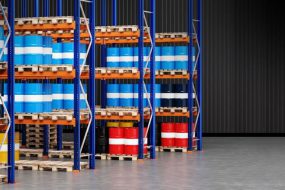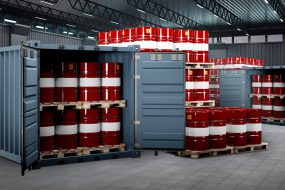Every day, businesses in industries such as healthcare and manufacturing handle materials they may not realise are classified as hazardous.40% of companies transporting dangerous goods invest more in compliance and logistics after uncovering these obligations during audits. Many everyday items, including chemicals, gases, and medical supplies, are deemed hazardous due to their potential risks to people and the environment. They require specialised handling to ensure safety and regulatory compliance. This article will explore essential practices for accurately identifying and managing hazardous materials, helping businesses minimise risks, maintain compliance, and avoid costly setbacks.
Classification of hazardous materials
What counts as hazardous materials?
Hazardous materials, or hazmat, are substances that, if mishandled, could put health, safety, or the environment at risk. These include toxic, flammable, corrosive, or reactive materials. Organisations such as the U.S. Department of Transportation (DOT) define them as materials that pose an “unreasonable risk” when transported.
Types of hazardous materials
Hazardous materials are grouped intonine different categoriesto ensure safe handling, each posing its unique dangers:
- Class 1: Explosives – Items that could create significant heat, smoke, or gas if triggered.
- Class 2: Gases – Flammable, compressed, or toxic gases such as propane and chlorine.
- Class 3: Flammable Liquids – Easily ignitable liquids, including petrol and alcohol.
- Class 4: Flammable Solids – Solids that ignite from friction or heat.
- Class 5: Oxidisers and Organic Peroxides – Materials like ammonium nitrate can exacerbate fires.
- Class 6: Toxic and Infectious Substances – Harmful if inhaled, ingested, or touched.
- Class 7: Radioactive Materials – Substances that emit radiation, including certain medical materials.
- Class 8: Corrosives – Materials such as sulphuric acid that can damage metals or tissues.
- Class 9: Miscellaneous Dangerous Goods – A catch-all for other hazardous materials.
Every class has its safety protocols, ensuring that transporting hazardous materials remains as safe as possible.
Labels, identification, and why they matter
To ensure safety, each package of hazardous materials must have unambiguous labels that inform handlers and responders about its contents and potential risks. Labels and essential shipping documents make it easy to identify materials at a glance, helping to prevent accidents and ensuring quick responses if an incident occurs. This system keeps everyone in the transport process well-informed and prepared.
Common misconceptions: Many think hazmat rules only apply to chemical companies, but items like batteries and cleaning supplies often qualify too—surprising first-time shippers and raising shipping costs.
Understanding basic safety guidelines
Moving hazardous materials isn’t just about loading and unloading; it involves following strict safety guidelines to protect people, property, and the environment. Organisations like DOT, IATA, and IMO have laid down specific packaging, labelling, and handling rules to minimise risks as much as possible. These guidelines will help companies avoid fines and delays and ensure safe, steady operations.
Compliance with transportation rules & regulations
Following safety guidelines for transport protects businesses from common pitfalls that new shippers often encounter. Properly training teams, so they understand and follow these protocols, means they are equipped to handle these materials correctly. By committing to safety standards, companies help create a work culture that reduces accidents, keeps operations reliable, and demonstrates a dedication to safety.
The must-have documents and permits
Documentation forms a critical component of hazardous materials transport safety protocols. Permits, safety data sheets (SDS), and shipping documents provide details on handling and emergency contacts, covering every step of the process. This paperwork shields businesses from liability and demonstrates a solid commitment to safety.
How proper packaging prevents disasters
Suitable packaging materials
Packaging is a key defence in safely transporting hazardous materials. Each material type needs specific packaging to remain secure and prevent leaks, spills, or accidents, protecting people and property. Using the proper containers also helps businesses avoid unexpected shipping costs tied to improper packaging—savings that often go unnoticed but can significantly impact the bottom line.
Handling tips and safety gear
People handling these materials must wear Personal Protective Equipment (PPE) and receive specialised training. Depending on the material, PPE may include gloves, goggles, or even respirators. Emergency response kits, spill kits, and clear segregation of incompatible materials (e.g., flammable liquids away from oxidisers) further protect handlers.
Special Considerations
Handling protocols differ based on the type of material, for instance:
- Explosives (Class 1) require packaging that minimises the risk of detonation, often with fire suppression systems in transport vehicles.
- Flammable Liquids (Class 3) necessitate containers that prevent sparks and static.
- Toxic Substances (Class 6) demand leak-proof packaging and well-ventilated spaces.
- Radioactive Materials (Class 7) require shielded containers and, at times, special route permits.
Transporting hazmat by land, air, and sea
Transport methods have their own unique rules:
Land transportation
Land transport remains one of the most common methods. Vehicles carrying hazardous materials must meet specific safety standards and display placards indicating what is on board. Routes are often planned to avoid busy or environmentally sensitive areas, and drivers receive special emergency training to prepare if anything goes wrong.
Air transportation
Air transport involves additional steps due to pressure changes at altitude. Specialised certified containers are a must. Tools like an air freight calculator also help logistics teams estimate costs and analyse freight rates while ensuring compliance with IATA Dangerous Goods Regulations. Airlines need advance notice of hazardous materials, and the crew must have full access to all related documentation.
Sea transportation
Shipping by sea uses the IMDG Code, which standardises how dangerous goods travel on vessels. Containers must meet maritime standards, and emergency plans must be in place to handle onboard incidents. Ports also set specific regulations for the handling and storage of hazardous materials, ensuring safe international transit.
Related article: The Benefits of Multimodal Transportation and Why It’s Worth It
Emergency plans and incident management
Even with careful protocols in place, incidents can occur. Emergency preparedness plays a crucial role in the transportation of hazardous materials.
Preparedness and response plans
Companies need firm emergency plans that cover how to manage, respond to, and recover from incidents. Regular updates and reviews are essential.
Training for everyone
Regular training ensures personnel maintain their emergency response capabilities, leading to more effective incident management.
Clear reporting and communication
Companies and even first responders learn from each incident by keeping detailed reports, preventing future issues and maintaining consistent operations.
Final thoughts
Hazardous materials transportation requires planning, the right equipment, and adherence to strict regulations. Each step guarantees the safe movement of dangerous goods. Understanding these steps enables businesses to evaluate freight quotes better, optimise costs, enhance employee safety, and build customer trust.
Are you still exploring hazardous materials transportation options? We’re here to help you get started.Contact our team today.




